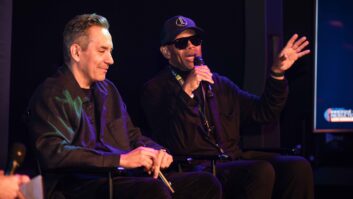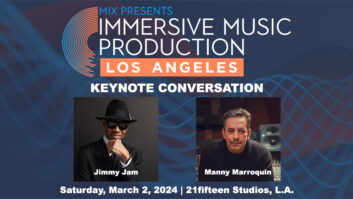
Rock stars don’t retire. If they did, with 56 years in service and counting, Suzi Quatro would have a hefty pension. The 70-year-old multi-instrumentalist and vocalist isn’t close to slowing down, not even during a pandemic.
In the midst of extensive media coverage and accolades for her documentary Suzi Q, which was released summer of 2020, Quatro provided video tutorials of her classic basslines—50 in total. She showed up for weekly performances of stripped-back versions of her songs in her “Sunday Specials” on Facebook Live. She also wrote and recorded a new album, The Devil in Me.
The Devil in Me is the second full-length Quatro has produced with her son, Richard Tuckey, whose father, Len Tuckey, played guitar in Quatro’s band during her original wave of prominence. Mother and son first worked together on 2019’s No Control. Tuckey proved himself an astute producer with a clear vision for Quatro, which is even more defined on The Devil in Me.
“My whole life I’ve watched her rock out live; that hasn’t translated onto an album for a few years,” says Tuckey from the demo studio at Quatro’s home in Essex, England. “I was trying to stay pure to what she really is, which is rock ‘n’ roll. She’s been that since she was 14. She’s not changed. I wanted to try and get her back to that feeling. I wanted to see if I could capture that kind of energy, and I believe we came pretty close.”
The Devil in Me is an equal mix of balls-out rockers, such as the rollicking “Hey Queenie,” the jaunty “Betty Who,” and the grinding title track, and heart-tugging ballads such as the Christmas-tinged “My Heart and Soul,” the aptly titled “Isolation Blues,” and the languorous “Loves Gone Bad.” The album is as signature Suzi Quatro as her earliest albums from the ’70s, which established her as the “Queen of Rock and Roll.”
WORKING OUT AT HOME
The songs “Do Ya Dance” and “Hey Queenie” were recorded by Tuckey with producer/engineer Noah Booth prior to The Devil in Me. They became the benchmarks for the album’s sound. Quatro came up with another eight or nine songs on the piano, her go-to instrument for songwriting. Meanwhile, Tuckey, an accomplished guitar player, compiled ideas by playing a bassline here, a drum beat there or a rhythm picked out on a keyboard, which he would then present to his mom.

In the home demo studio Quatro, Tuckey and Booth create reference recordings for Quatro’s band in Apple Logic X, using Universal Audio Apollo 8 interfaces and monitoring through KRK speakers. At this stage, the idea is to work as fluidly as possible. Everything is set up so Quatro or Tuckey can be recorded at all times: the vocal microphone, the mics on the guitar amp, the electric piano and the bass DI are always in place.
Says Tuckey of the guitar recording: “We took a very similar approach to what my dad and Mike Chapman used to take in the ’70s—that is, plug your guitar into the amp. We used different guitars for different sounds rather than a lot of pedals and amps. We used a couple of different Telecasters, a Les Paul custom, a 335, and a couple of Stratocasters. We had two amps: Doctor Z MAZ 38 NR with a 2×12 cab with a Celestion Vintage 30 on the top and Greenback on the bottom. We used a 1967 little Fender Vibro Champ amp combo for some stuff, as well.”
“We had three mics plugged in a couple of feet away from [Tuckey],” says Booth. “We were getting the tone in the room and matching the guitars to the track and to what’s happening around us. It felt more organic and a lot better to do it that way, instead of miking up an amp and then setting it up through a set of monitors and you’re second-guessing whether it is the monitors or the mic.”
ON TO RAK STUDIOS
After the demo stage, a few days were spent at Quatro’s old stomping grounds, RAK Studios in London. Here, they record bass and drums together, then keyboards and horns on separate days. Engineer Wes Maebe was on hand for these sessions where Tuckey recorded his guitar parts for “Betty Who” using Mickie Most’s original ’58 Stratocaster through a ’67 Vox AC30 with a treble boost. Maebe added a Sennheiser 421 microphone behind the amp for a live take of the sound.
RAK is where the inimitable drum sound is captured on a Rogers kit with a Black Beauty snare and a basic mic setup. For the very ‘70s sound of “My Heart and Soul,” Maebe miked the drums with Coles overheads, Sennheiser 421 on the toms and Shure SM57 on the snare top and bottom, recorded into RAK’s API desk.

“The mix engineer, Tom Pullen, slammed stuff quite a lot,” says Booth. “He is using quite a bit of parallel compression, bringing it up and down that way and using the actual sound of the room as much as possible rather than using a room emulation. Tim Reyland being the drummer he is made the drums sound the way they sound, and that’s the biggest key point about it. Having Suzi and Tim play at the same time, locking together and locking that groove, that was really important. That’s how people made records in the ’70s. They played together, that’s the best part of it.”
Both at the home studio and at RAK, Quatro’s trusty Fender Precision bass is plugged in DI more often than not, although Most’s Ampeg was used for the songs that needed amp ambiance. “I don’t always like to do that,” says Quatro, “but some tracks may require it, for instance the ones that should be picked, and I don’t pick.
“‘Hey Queenie’ is one of my best basslines ever,” she continues. “There have been two songs in my career that I had to practice playing a song and singing: “She’s in Love With You,” it’s like a machine playing and the vocals are behind it, and “The Girl from Detroit City,” very Motown bassline and the vocal is completely the opposite. “Hey Queenie” is the third. A jazz walking bass part with an abnormal chord sequence, and I’m singing completely against it.”
In addition to the P-bass, Quatro uses a fretless Fender Kingman, a gift from Andy Scott of The Sweet, for more atmospheric songs like “In the Dark” and “Love’s Gone Bad.” Says Quatro, “I love that fretless sound because it’s so challenging. You can’t be a millimeter out. You’ve got to be exact.”
She also uses a custom Red Heeter Rios bass, as well as a Jazz bass, which is the one that she uses on tour. “I practice and play in the studio with the Precision because it has the widest neck. When you practice with the widest and go on the stage with the little bit slimmer neck at the bottom, you feel the difference. When you’re running around with a bass, it’s a little bit easier. But in the studio. I’m stuck on the Precision. It’s the best sound.”
LAYING DOWN THE VOCAL
The final studio was Rooks Yard near Quatro’s home, where vocals were recorded through the same vocal chain as for the demos, for the most part. The demo vocals were tracked with a Neumann TLM 103 into UA Apollo 8 with a Unison U610B preamp and UAD LA-2A compression, “to keep things upfront and vibey,” according to Booth. For the final vocals heard on The Devil in Me, Quatro sang into a Warm Audio 251 microphone, into a Neve 1073LB preamp, UA 1176LN then Apollo 8.
“I usually lay down backing vocals myself,” Quatro says. “I always know which lines need a harmony. I can harmonize with myself. I can sound like an entire choir. I always know which songs I should double-track a chorus. I know my voice. I can double-track with my voice perfectly, never miss a beat. I’m very good at it because I’m from Detroit. Motown is all backing vocals. Everyone can learn from that.”
“When [Quatro] is doing her vocals, she wants to hear a full track that sounds good,” says Booth, who added Eventide TVerb to the backing vocals. “She wants to be able to sit in the track. She doesn’t want to imagine the track. When we were doing the vocals, everything was falling in together and you’d quickly realize, ‘This shouldn’t be here, that shouldn’t be there.’ It was done on the fly with everyone.”

“If something’s not very good, I won’t beat around the bush,” adds Tuckey. “I expect exactly the same for me. It just gets things done. There’s no harshness. A lot of people will be intimidated to say what they feel. Why beat around the bush, especially in rock ‘n’ roll?”
“When I was putting the final vocal on ‘My Heart and Soul,’ at the moment when you’re most vulnerable, people are listening and you’re hoping it’s all coming out right, Richard stopped the tape,” recounts Quatro. “He said, ‘You’re not doing it, Mom.’ I got defensive immediately, even with all my experience. He said, ‘I didn’t get goosebumps and I did before.’ He played me the demo—sometime your demo can be your enemy—and I heard my voice on the demo and he was 100 percent correct. It was sensitive of him to have heard it, and smart of him to know what he wasn’t hearing and how to get it from me.
“It took awhile to develop that trust,” she continues. “But Richard said, ‘I know what this album should sound like. I know what you should be doing at this stage of your career. I want this album to be as groundbreaking as the first one.’ You’ve got to trust this guy, don’t you?”







